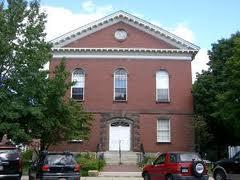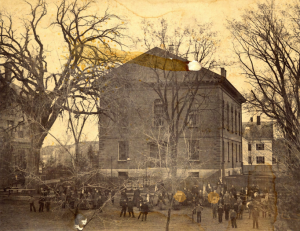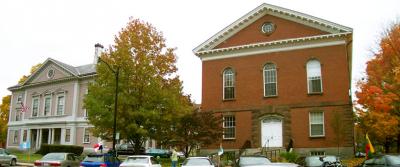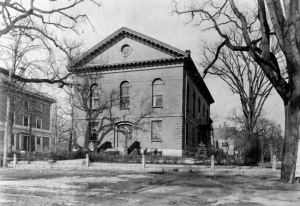After 150 Years, Concord's Town House Gets A Much Needed Restoration

In 2012 the Town of Concord began a two-year, CPA-funded project to restore their historic Town House. The Italianate-style structure, located at 22 Monument Square, was built in 1851 in the midst of a thriving agriculture and urban market economy fueled by the expanse of railroads during that time period.
The building underwent two major renovations including an 1879-80 rear addition and a 1930s remodeling. Smaller, more recent changes have addressed concerns surrounding accessibility, climate control and fire safety. The building last underwent work in 2006-2009, with the rehabilitation of the roof and work to install a sprinkler system and fire alarm. Prior to those updates, no major work had been completed on the structure since 1930. About fifty percent of both the 2006 and 2009 additions were CPA-funded projects, tallying to $228,750 and $95,400 in total costs, respectively.
 Yet in 2012, after 150 years of continuous use, the exterior’s brownstone and brick deterioration had become a noticeable problem. Despite the structure's periodic updates and renovations, no work had ever been done on the masonry exterior. The Concord Town Manager’s office and the Board of Selectmen brought these concerns about the building – still used to house the Town Manager’s Office, Finance, Town Clerk, Treasurer, the Selectmen’s meeting room and Public Hearing rooms – to the forefront. In an effort to thwart more significant damage and research appropriate solutions, the town acquired about $50,000 in CPA funds in 2012 to conduct a historic structure assessment and create a detailed blueprint for restoration of the exterior facades. This preplanning allowed the building to remain fully operational and open to the public even after the restoration construction began.
Yet in 2012, after 150 years of continuous use, the exterior’s brownstone and brick deterioration had become a noticeable problem. Despite the structure's periodic updates and renovations, no work had ever been done on the masonry exterior. The Concord Town Manager’s office and the Board of Selectmen brought these concerns about the building – still used to house the Town Manager’s Office, Finance, Town Clerk, Treasurer, the Selectmen’s meeting room and Public Hearing rooms – to the forefront. In an effort to thwart more significant damage and research appropriate solutions, the town acquired about $50,000 in CPA funds in 2012 to conduct a historic structure assessment and create a detailed blueprint for restoration of the exterior facades. This preplanning allowed the building to remain fully operational and open to the public even after the restoration construction began.
Concord Senior Planner Lara Kritzer said the Town House embodies Concord’s identity, past and present. “The structure is at the heart of the community, geographically and socially, and has housed not only the Town offices but its archives, schoolrooms, library, and armory at various times in its history,” she said.
The total cost of the restoration project rang in at $1.75 million, $800,000 of which came from Community Preservation funds that were appropriated by a Town Meeting vote in 2013. The remaining $950,000 in cost was provided by the town.
Kritzer noted that this CPA expenditure “constitutes one of Concord’s largest single CPA fund allocations.” She added, “while there was discussion, there was no question that the building deserved this investment.”
 The Town House construction included a full restoration of the exterior facades, including extensive brownstone trim repairs, masonry work and restoration of the original window pattern and paint colors. The treatment of the brownstone trim elements ranged from a mix of patching and pinning to full replacement of stones.
The Town House construction included a full restoration of the exterior facades, including extensive brownstone trim repairs, masonry work and restoration of the original window pattern and paint colors. The treatment of the brownstone trim elements ranged from a mix of patching and pinning to full replacement of stones.
The project also removed the North Elevation fire escape, contingent upon containing occupancy levels in the Selectmen’s Room to 35 people. This removal was deemed permissible under State Building Code (8th edition) and allowed workers to access and replace the band stone in that area of the building. Due to the scale of the project, plans also complied with the Rules and Regulations of the Architectural Access Board (AAB).
Kritzer said CPA played an invaluable role in completing this restoration. "CPA funding has made this and other projects,” Kritzer said citing the saving and restoration of the Barrett Farm and the Caesar Robbins House, in addition to accessibility improvements for the Concord Art Association’s 1700s home, structural repairs to the Orchard House and Bronson Alcott’s School of Philosophy, “all possible in a climate where few other historic preservation funding resources exist.”
 A House Steeped in History
A House Steeped in History
Originally, the Town House’s site was selected for its proximity to the then-new Middlesex County Courthouse. In the mid-1800s, Concord broke ground on the House which cost the town roughly $19,000 in total, including fees for construction, site preparation, materials and final furnishings. The House’s original survey documents were produced by Henry David Thoreau.
In the Town House’s early years, its principle use was to host government offices and store town records. It also served as a stage for political meetings and became the center of community life in Concord. The House’s assembly hall was frequently rented out for social gatherings, educational events, entertainment, and for the commemoration of national or local holidays or observances. Town House was described “a large, handsome and durable building…” that “will long stand, a monument of the forecast, enterprise and liberty of the present generation,” according to the Concord’s March 7, 1953 Annual Report of the Town Officers: Reports of the Town Building Committee.
The Town House’s first floor housed town clerk, tax collector and treasurer offices with two school rooms located toward the rear. The next level up contained the assembly hall, a library containing legal, parish and agricultural collections, and a vault for Town Records. Historic figures including Thoreau, Ralph Waldo Emerson and John Brown were among those to grace the assembly hall floor to give lectures and speeches.
Toward the end of the century, the House continued to be used for charity functions, graduation ceremonies, and Centennial celebrations. Into the 20th Century the building continued to take on more town and government roles, serving as the site for public hearings and other town sponsored events.
Future of the House
According to Kritzer, the role of the Town House in Concord’s everyday town functions and identity is one of the reasons the town invested so much time, funds and energy into this project. Moving forward, the Town House will continue to be used for its “original purpose as the central municipal building and meeting space for the foreseeable future,” said Kritzer, noting future improvements laid out for the building’s interior. “In fact, work is currently underway to update the first floor offices and the building’s communications systems at this time,” she noted.
Now restored and sound on the exterior, the Concord Town House will remain an important fixture in a community that, according to Kritzer, “certainly does not lack for historic sites.” She added that the investment of CPA and other town funds in this project “says a lot about how much the community values its history and culture.”
Details on the restorations were sourced from an assessment on the Town House prepared by McGinley Kalsow & Associates, Inc. Other information came from Concord Deputy Town Manager, Douglas Meagher and Concord Senior Planner, Lara Kritzer.

